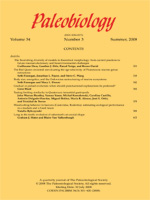Fossil marine lineages are generally expected to exhibit long-term trends of increasing body size because of inherent fitness advantages or secular changes in environmental conditions. Because empirical documentation of this trend during the Paleozoic has been lacking for most taxonomic groups, the magnitude, timing, and taxonomic breadth of the trend have remained elusive. This study uses the largest existing database of fossil invertebrate sizes from four faunally important phyla to document ecosystem-wide size trends in well-preserved biotas from deep-subtidal, soft-substrate assemblages during the Cambrian through Devonian. Size of type specimens was measured along standard body axes from monographic plates and converted to body volume by using a broadly applicable empirical regression. Results demonstrate that mean body size (herein volume) of individual genera doubles during this interval, especially from the Late Ordovician through Early Devonian. The timing is gradual in spite of major radiations and extinctions, and the increase is primarily attributable to a net increase in the three-dimensionality of genera. The overall increase is not caused by replacement among clades because increases are widespread among arthropods, brachiopods, and echinoderms, at the phylum and class levels; in contrast, mollusks do not display a net size change at either taxonomic level. The increase is also more pronounced in microbivores than in carnivores. Combined with known environmental changes during this interval, and especially records of carbon dioxide, these trends provide support for the claim that primary productivity increased during the early to mid Paleozoic.
How to translate text using browser tools
1 March 2008
Ecosystem-wide body-size trends in Cambrian–Devonian marine invertebrate lineages
Philip M. Novack-Gottshall
ACCESS THE FULL ARTICLE

Paleobiology
Vol. 34 • No. 2
March 2008
Vol. 34 • No. 2
March 2008




